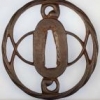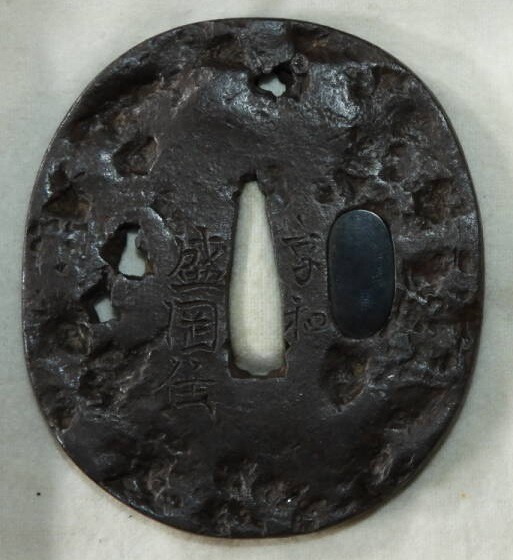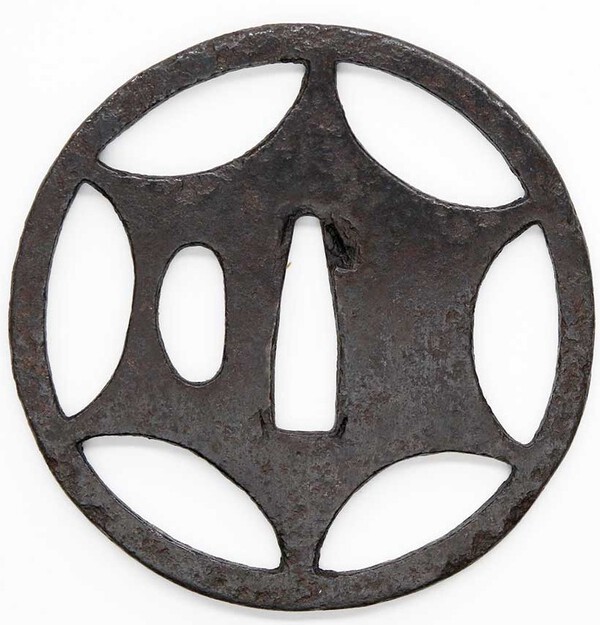-
Posts
323 -
Joined
-
Last visited
Everything posted by lotus
-
Florian - Yes, I could see a possible Akasaka attribution here. It does share traits common to that school. It is a really nice Tsuba that is for sure.
-
Ken - I have the exact same issue with one of my Tsuba. I recall someone mentioning taking some baking soda and a damp cloth to it. This seems to work when the rust is of the loose type. I have not tried that on my Tsuba yet, but I plan on shortly. I have my doubts it will work as I do not think the rust is of that type. Also, I fear any modern approaches will cause more harm to the patina which would force a need for repatination, which is a tricky business to attempt. Ideally, we would need an approach that removes the rust in those tiny pin-prick sports yet does not harm the surrounding patina.
-
Found a couple similar. The attached pic below shows mine in the middle. I think mine is quite similar to the 1st one which is estimated to be possibly sandai or yondai Takahashi (1700 - 1800). Perhaps mine might be dated to a similar era.
-
Indeed it was written with a ball point pen though the Tsuba came from Japan.
-
Thank you Steve, I am thinking at some point in this boxes life, there was a Soten Tsuba residing in it!
-
Somewhat recent acquisition, Echizen Kinai School, probably student work? Also, what era would you say? Dimensions are 77 mm round, 4.5 mm edge thickness
-
Mainly due to thickness and somewhat due to busy-ness of design, I would not favor Ko-Shoami. However, early Edo Kyo-Shoami is a possibility (or Shoami) as I have seen them run thick like that. Akao, another possibility.
-
Malcom - Nice find. I am interested to know if method 4 actual works as it seems very simple. Maybe I will give it a go on a test Tsuba. Though, would be curious to know which oil is best to use.
-
Fantastic video, thanks for sharing!
-
Which are his best Tsuba books?
-
Christian - I like your ideas very much.
-
I ordered the PDF and am very pleased with it. You can zoom in a decent amount. Higher rez images would have been awesome but would have probably doubled the size of the PDF. Though in this day and age, storage is cheap...
-
Geraint - Thanks, I will check that out. Until then, I photo shopped a couple nunome zogan designs onto my guard. Think I prefer the 2nd one...
-
Yes indeed, you both make excellent points. I will look into schools specializing in nunome or iroe zogan then. Geraint, yes those marks could be preparation for nunome zogan. The tsuba identification guide does list Heianjo as doing both low relief and nunome inlay. And Hayes states they used both raised and flat. I assume by flat he is referring to nunome?
-
Jean - Very good points on Katchushi, thank you. And Florian, I absolutely agree with your statements on the desire to classify tsuba! Speaking of which, I inspected my new tsuba under magnification and lo and behold on one area where the patina has rubbed off, I found traces of inlay in 3 places (see attached photos). I also found what I think is evidence of "file" like marks used to remove the inlay (see red arrow on 2nd pic). My theory is that someone had the inlay removed and the tsuba re-patinated because in all other areas where patina is intact there is no evidence of inlay. That said, all current evidence points to a Heianjo call based on diameter, rim width (broad) and it being rounded square, thickness and with evidence of inlay on the rim. Why not Shoami you say? The broad flat and rounded square rim along with inlay being on the rim like in most Heianjo guards. The design is slightly different then what we see in this school as it has more of a Kanayama feel to it but I think it is still the best call... I am going to play in photoshop and see if I can add some decoration to it just to "visualize" it. My PS skills are rusty so not sure how good it will come out. Do others now agree with this call given the new evidence?
-
Jean - I very much agree with you, but I have also read (Haynes) that they made tsuba throughout the Edo period and moved on from there older style to adjust for the tastes of the times. That said, they seemed to still be thin and quite large like you said. In that way, I agree that a Katchushi call is probably not applicable for mine. Though, I would be curious as what NBTHK would determine.
-
Thanks Chris, the patina is deep and dark with mirror like finish. I think the fabric surrounding the tsuba when I photographed it imparted a purple/reddish tint which it does not possess. A papered Katchushi tsuba popped up at Aoi Art that demonstrates the wide rim of which I spoke in my previous post. Though I am unsure my tsuba is large enough to be considered for this bucket...
-
Marius - Understood, this one does not fit neatly into any of the categories. I am just treating the votes more like guesses anyway. And yes, I am really liking this one! Your input is much appreciated.
-
Not including my vote, we have Kanayama (3), Akasaka (1), Owari (1), and Ko-Shoami (1). Florian, thanks for letting me know about the migaki (mirror-like) finish. That is exactly how I would describe it. So, not Yakite shitate after all. Based on another discussion that had an papered attribution of Katchushi based on a wide rim and rather large diameter, I was wondering if Katchushi might be another possibility? Ironically, I was very much questioning that call. Discussion here : http://www.militaria.co.za/nmb/topic/26779-attribution-for-this-hozon-papered-tsuba/ As for the missing piece, I see faint evidence of file marks. So, not purposely omitted.
-
I agree with the Jakushi call and yes, appears real. One just sold on ebay for 77 USD. It had more decoration but otherwise fairly similar. That one, however, had the mei on the other side for whatever reason.
-
Yeah, I spent some time going through the books and as far as style, it seemed to fit the Kanayama school pretty well. The wider rim also points to them and maybe even the finish. Though most Kanayama tsuba are thicker, even though I found some in the 4-5mm range.
-
Mokko gata shaped (78.5 wide, 79 tall, rim thickness around 4 mm and ever so slightly less around seppa) Rounded square rim and very light in hand. One piece is missing or purposely removed (hard to tell that was done unless inspecting closely). Probably the most interesting characteristic is the finish (where not corroded) as it is nothing like any of my other tsuba. It is has a glass like smoothness which you could almost intepret as black lacquer except acetone did not touch it. Could it be possibly be Yakite shitate? If so, does that help narrow down the school? I have some thoughts on a school but would rather hear what others think and not bias it.... Also, any thoughts on motif? Thanks!
-
Yeah, was basically wondering if you can see more detail in the ebook vs printed. If so, that makes the decision easy peasy.


















